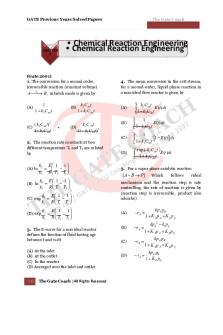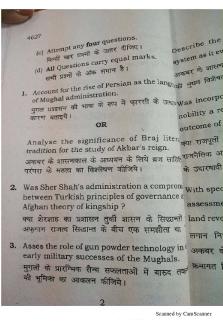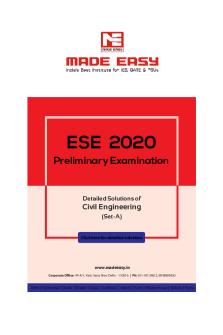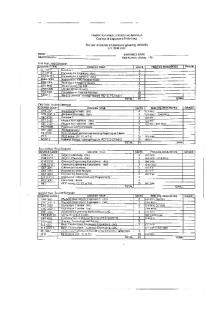GATE Solved Question Papers for Chemical Engineering CH20191024 5353 j4gzcg PDF

| Title | GATE Solved Question Papers for Chemical Engineering CH20191024 5353 j4gzcg |
|---|---|
| Author | AglaSem EduTech |
| Pages | 68 |
| File Size | 2 MB |
| File Type | |
| Total Downloads | 24 |
| Total Views | 178 |
Summary
GATE Previous Year Solved Paper Chemical Engineering - CH 2012-15 ________________________________________________________________ GATE Previous Year Solved Papers by GATE 2015 Solved Paper Chemical Enginnering - CH Duration: 180 minutes Maximum Marks: 100 Read the following instructions carefully. ...
Description
GATE Previous Year Solved Paper Chemical Engineering - CH
2012-15
________________________________________________________________ GATE Previous Year Solved Papers by
GATE 2015 Solved Paper Chemical Enginnering - CH Duration: 180 minutes
Maximum Marks: 100
Read the following instructions carefully. 1. To login, enter your Registration Number and password provided to you. Kindly go through the various symbols used in the test and understand their meaning before you start the examination. 2. Once you login and after the start of the examination, you can view all the questions in the question paper, by clicking on the View All Questions button in the screen. 3. This question paper consists of 2 sections, General Aptitude (GA) for 15 marks and the subject specific GATE paper for 85 marks. Both these sections are compulsory. The GA section consists of 10 questions. Question numbers 1 to 5 are of 1-mark each, while question numbers 6 to 10 are of 2-mark each. The subject specific GATE paper section consists of 55 questions, out of which question numbers 1 to 25 are of 1-mark each, while question numbers 26 to 55 are of 2-mark each. 4. Depending upon the GATE paper, there may be useful common data that may be required for answering the questions. If the paper has such useful data, the same can be viewed by clicking on the Useful Common Data button that appears at the top, right hand side of the screen. 5. The computer allotted to you at the examination center runs specialized software that permits only one answer to be selected for multiple-choice questions using a mouse and to enter a suitable number for the numerical answer type questions using the virtual keyboard and mouse. 6. Your answers shall be updated and saved on a server periodically and also at the end of the examination. The examination will stop automatically at the end of 180 minutes. 7. In each paper a candidate can answer a total of 65 questions carrying 100 marks. 8. The question paper may consist of questions of multiple choice type (MCQ) and numerical answer type. 9. Multiple choice type questions will have four choices against A, B, C, D, out of which only ONE is the correct answer. The candidate has to choose the correct answer by clicking on the bubble (⃝) placed before the choice. 10. For numerical answer type questions, each question will have a numerical answer and there will not be any choices. For these questions, the answer should be enteredby using the virtual keyboard that appears on the monitor and the mouse. 11. All questions that are not attempted will result in zero marks. However, wrong answers for multiple choice type questions (MCQ) will result in NEGATIVE marks. For all MCQ questions a wrong answer will result in deduction of⅓ marks for a 1-mark question and ⅔ marks for a 2-mark question. 12. There is NO NEGATIVE MARKING for questions of NUMERICAL ANSWER TYPE. 13. Non-programmable type Calculator is allowed. Charts, graph sheets, and mathematical tables are NOT allowed in the Examination Hall. You must use the Scribble pad provided to you at the examination centre for all your rough work. The Scribble Pad has to be returned at the end of the examination. Declaration by the candidate: “I have read and understood all the above instructions. I have also read and understood clearly the instructions given on the admit card and shall follow the same. I also understand that in case I am found to violate any of these instructions, my candidature is liable to be cancelled. I also confirm that at the start of the examination all the computer hardware allotted to me are in proper working condition”.
_________________________________________________________ GATE Previous Year Solved Papers by
GATE 2015 General Aptitude - GA _______________________________________________________________ Q.1 to Q5. carry 1 mark each & Q.6 to Q.10 carry 2 marks each. Question Number : 1 Question Type : MCQ Choose the most appropriate word from the options given below to complete the following sentence. The principal presented the chief guest with a ____________, as token of appreciation. (A) momento (B) memento (C) momentum (D) moment Question Number : 2 Question Type : MCQ Choose the appropriate word/phrase, out of the four options given below, to complete the following sentence : Frogs ___________. (A) croak (B) roar (C) hiss
(D) patter
Question Number : 3 Question Type : MCQ Choose the word moist similar in meaning to the given word : Educe (A) Exert
(A) -2
(B) Educate
(B) -1
(C) Extract
(D) Extend
(C) 1
(D) 2
(A) 343/125 (B) 125/343 (C) -25/49 (D) -49/25 Question Number : 6 Question Type : MCQ The following question present a sentence, part of which is underlined. Beneath the sentence you find four ways phrasing the underlined part. Following the requirements of the standard written English, select the answer that produces the most effective sentence. Tuberculosis, together with its effects, ranks one of the leading causes of death in India. (A) ranks as one of the leading causes of death (B) rank as one of the leading causes of death (C) has the rank of one of the leading causes of death (D) are one of the leading causes of death
_______________________________________________________________ GATE Previous Year Solved Papers by
GATE 2015 General Aptitude - GA _______________________________________________________________ Question Number : 7 Question Type : MCQ Read the following paragraph and choose the correct statement. Climate change has reduced human security and threatened human well being. An ignored reality of human progress is that human security largely depends upon environmental security. But on the contrary, human progress seems contradictory to environmental security. To keep up both at the required level is a suitable scientific innovations, while the other may be the Gandhian perspective on small scale progress with focus on sustainability. (A) Human progress and security are positively associated with environmental security. (B) Human progress is contradictory to environmental security. (C) Human security is contradictory to environmental security. (D) Human progress depends upon environmental security. Question Number : 8 Question Type : NAT Fill in the missing value
Question Number : 9 Question Type : MCQ A cube of side 3 units is formed using a set of smaller cubes of side 1 unit. Find the proportion of the number of the smaller cubes visible to those which are NOT visible. (A) 1:4
(B) 1:3
(C) 1:2
(D) 2:3
Question Number : 10 Question Type : MCQ Which one of the statement below is logically valid and can be inferred from the above sentences? (A) Humpty Dumpty always falls while having lunch (B) Humpty Dumpty does not fall sometimes while having lunch (C) Humpty Dumpty never falls during dinner (D) When Humpty Dumpty does not sit on the wall, the wall does not break.
_______________________________________________________________ GATE Previous Year Solved Papers by
GATE 2015
CHEMICAL – CH
Q. 1 – Q. 25 carry one mark each. Q.1 The following set of three vectors
𝑥𝑥 1 3 �2�, �6� and �4�, 𝑥𝑥 1 2
is linearly dependent when x is equal to (A)
0
Q.2 For the matrix �4 3 Q.3
(B)
1
(C)
2
(D)
3
3 1 �, if � � is an eigenvector, the corresponding eigenvalue is ______. 4 1
Consider a linear ordinary differential equation:
dy + p( x ) y = r ( x ) . Functions p( x ) and r ( x ) are dx
defined and have a continuous first derivative. The integrating factor of this equation is non-zero. Multiplying this equation by its integrating factor converts this into a: (A) Homogeneous differential equation (C) Second order differential equation
(B) Non-linear differential equation (D) Exact differential equation
Q.4 A complex-valued function, f(z), given below is analytic in domain D:
f ( z ) = u ( x, y ) + iv(x, y )
z = x + iy
Which of the following is NOT correct?
∂u df ∂v = +i dz ∂y ∂y df ∂v ∂u = −i (C) dz ∂y ∂y (A)
df ∂u ∂v = +i dz ∂x ∂x df ∂v ∂v = +i (D) dz ∂y ∂x (B)
Q.5 A scalar function in the xy-plane is given by 𝜙𝜙(𝑥𝑥, 𝑦𝑦) = 𝑥𝑥 2 + 𝑦𝑦 2 . If iˆ and ˆj are unit vectors in the x and y directions, the direction of maximum increase in the value of 𝜙𝜙 at (1,1) is along: (A) −2 iˆ + 2 ˆj (C) −2 iˆ − 2 ˆj
(B) 2 iˆ + 2 ˆj
(D) 2 iˆ − 2 ˆj
Q.6 For a pure liquid, the rate of change of vapour pressure with temperature is 0.1 bar/K in the temperature range of 300 to 350 K. If the boiling point of the liquid at 2 bar is 320 K, the temperature (in K) at which it will boil at 1 bar (up to one decimal place) is ______________.
Q.7 Three identical closed systems of a pure gas are taken from an initial temperature and pressure (T1, P1) to a final state (T2, P2), each by a different path. Which of the following is ALWAYS TRUE for the three systems? (∆ represents the change between the initial and final states; U, S, G, Q and W are internal energy, entropy, Gibbs free energy, heat added and work done, respectively.) (A) ∆U, ∆S, Q are same (C) ∆S, W, Q are same
(B) W, ∆U, ∆G are same (D) ∆G, ∆U, ∆S are same
GATE Previous Year Solved Papers by
GATE 2015
CHEMICAL – CH
Q.8 For a gas phase cracking reaction A → B + C at 300°C, the Gibbs free energy of the reaction at this temperature is ∆G° = −2750 J/mol. The pressure is 1 bar and the gas phase can be assumed to be ideal. The universal gas constant R = 8.314 J/mol.K. The fractional molar conversion of A at equilibrium is: (A) 0.44
Q.9
(B) 0.50
(C) 0.64
(D) 0.80
If v, u, s and g represent respectively the molar volume, molar internal energy, molar entropy and molar Gibbs free energy, then match the entries in the left and right columns below and choose the correct option. P. − (∂u/∂v)s
I.
Temperature
Q.
(∂g/∂P)T
II.
Pressure
R.
− (∂g/∂T)P
III. v
S.
(∂u/∂s)v
IV. s
(A) P-II, Q-III, R-IV, S-I (B) P-II, Q-IV, R-III, S-I (C) P-I, Q-IV, R-II, S-III (D) P-III, Q-II, R-IV, S-I Q.10
Two different liquids are flowing through different pipes of the same diameter. In the first pipe, the flow is laminar with centerline velocity, 𝑉𝑉max ,1 , whereas in the second pipe, the flow is turbulent. For turbulent flow, the average velocity is 0.82 times the centerline velocity, 𝑉𝑉max ,2 . For equal volumetric flow rates in both the pipes, the ratio 𝑉𝑉max ,1 /𝑉𝑉max ,2 (up to two decimal places) is ________.
Q.11 For uniform laminar flow over a flat plate, the thickness of the boundary layer, 𝛿𝛿, at a distance x from the leading edge of the plate follows the relation: (A) 𝛿𝛿(𝑥𝑥) ∝ 𝑥𝑥 −1 (C) 𝛿𝛿(𝑥𝑥) ∝ 𝑥𝑥 1/2
(B) 𝛿𝛿(𝑥𝑥) ∝ 𝑥𝑥 (D) 𝛿𝛿(𝑥𝑥) ∝ 𝑥𝑥 −1/2
Q.12 A cylindrical packed bed of height 1 m is filled with equal sized spherical particles. The particles are nonporous and have a density of 1500 kg/m3. The void fraction of the bed is 0.45. The bed is fluidized using air (density 1 kg/m3). If the acceleration due to gravity is 9.8 m/s2, the pressure drop (in Pa) across the bed at incipient fluidization (up to one decimal place) is _____________.
GATE Previous Year Solved Papers by
GATE 2015
CHEMICAL – CH
Q.13 Two infinitely large parallel plates (I and II ) are held at temperatures TI and TII (TI > TII) respectively, and placed at a distance 2d apart in vacuum. An infinitely large flat radiation shield (III) is placed in parallel in between I and II. The emissivities of all the plates are equal. The ratio of the steady state radiative heat fluxes with and without the shield is:
(A) 0.5
(B) 0.75
(C) 0.25
(D) 0
Q.14 For a binary mixture of components A and B, NA and NB denote the total molar fluxes of components A and B, respectively. JA and JB are the corresponding molar diffusive fluxes. Which of the following is true for equimolar counter-diffusion in the binary mixture? (A) (B) (C) (D)
NA + NB NA + NB NA + NB NA + NB
= ≠ ≠ =
0 0 0 0
and and and and
JA + JB JA + JB JA + JB JA + JB
≠ = ≠ =
0 0 0 0
Q.15 Benzene is removed from air by absorbing it in a non-volatile wash-oil at 100 kPa in a countercurrent gas absorber. Gas flow rate is 100 mol/min , which includes 2 mol/min of benzene. The flow rate of wash-oil is 50 mol/min. Vapor pressure of benzene at the column conditions is 50 kPa. Benzene forms an ideal solution with the wash-oil and the column is operating at steady state. Gas phase can be assumed to follow ideal gas law. Neglect the change in molar flow rates of liquid and gas phases inside the column. For this process, the value of the absorption factor (up to two decimal places) is ___________.
Q.16 A spherical naphthalene ball of 2 mm diameter is subliming very slowly in stagnant air at 25°C. The change in the size of the ball during the sublimation can be neglected. The diffusivity of naphthalene in air at 25°C is 1.1×10−6 m2/s. The value of mass transfer coefficient is B × 10-3 m/s, where B (up to one decimal place) is ___________. Q.17 Which of the following can change if only the catalyst is changed for a reaction system? (A) (B) (C) (D)
Enthalpy of reaction Activation energy Free energy of the reaction Equilibrium constant.
GATE Previous Year Solved Papers by
GATE 2015
CHEMICAL – CH
Q.18 For which reaction order, the half-life of the reactant is half of the full lifetime (time for 100 % conversion) of the reactant ? (A) (B) (C) (D)
Zero order Half order First order Second order
Q.19 An irreversible, homogeneous reaction A → products, has the rate expression:
2C A + 0.1C A , where CA is the concentration of A. 1 + 50 C A 2
Rate =
CA varies in the range 0.5 - 50 mol/m3. For very high concentrations of A, the reaction order tends to: (A) 0
(B) 1
(C) 1.5
(D) 2
Q.20 Match the output signals as obtained from four measuring devices in response to a unit step change in the input signal. I
I
P: Gas chromatograph, with a long capillary tube
IIII
Output Signal
Q: Venturi tube III
III
R: Thermocouple with first order dynamics
IV
S: Pressure transducer with second order dynamics
time (A) P-IV, Q-III, R-II, S-I (C) P-IV, Q-I, R-II, S-III
(B) P-III, Q-I, R-II, S-IV (D) P-II, Q-IV, R-III, S-I
Q.21 The transfer function for the disturbance response in an open-loop process is given by Gdopen (s ) . The corresponding transfer function for the disturbance response in a closed-loop feedback control system with proportional controller is given by Gdclosed (s ) . Select the option that is ALWAYS correct { O[G (s )] represents order of transfer function G (s ) }:
[ O[G O[G O[G
(s )] = O[Gdclosed (s )] open (s )] ≠ O[Gdclosed (s )] d open (s )] ≥ O[Gdclosed (s )] d open (s )] ≤ O[Gdclosed (s )] d open
(A) O Gd (B) (C) (D)
GATE Previous Year Solved Papers by
GATE 2015
CHEMICAL – CH
Q.22 Identify the WRONG statement amongst the following: (A) (B) (C) (D)
Steam distillation is used for mixtures that are immiscible with water. Vacuum distillation is used for mixtures that are miscible with water. Steam distillation is used for mixtures that are miscible with water. Vacuum distillation columns have larger diameters as compared to atmospheric columns for the same throughput.
Q.23 Match the polymer mentioned on the left with the catalyst used for its manufacture given on the right. (I) Low density Polyethylene (II) High density Polyethylene (III) Polyethylene Terephthalate (IV) Polyvinyl Chloride (A) (B) (C) (D) Q.24
(P) Ziegler-Natta catalyst (Q) Traces of Oxygen (R) Butyl Lithium (S) Antimony
I-Q, II-R, III-S, IV-P I-S, II-P, III-Q, IV-R I-Q, II-P, III-S, IV-R I-S, II-R, III-P, IV-Q
Match the technologies in Group 1 with the entries in Group 2: Group 1
Group 2
P. Urea manufacture
I. Microencapsulation
Q. Coal gasification
II. Ultra-low sulphur diesel
R. Controlled release of chemicals
III. Shale oil
S. Deep hydrodesulphurization
IV. Prilling tower V. Gas hydrates VI. Gas-solid non-catalytic reaction
(A) P-I, Q-V, R-II, S-VI (C) P-IV, Q-I, R-III, S-II Q.25
(B) P-IV, Q-VI, R-I, S-II (D) P-V, Q-VI, R-IV, S-II
Match the chemicals written on the left with the raw materials required to produce them mentioned on the right. (I) Single Superphosphate (SSP) (II) Triple Superphosphate (TSP) (III) Diammonium Phosphate (DAP) (IV) Caustic soda (A) (B) (C) (D)
(P) Rock phosphate + Sulfuric Acid + Ammonia (Q) Brine (R) Rock phosphate + Sulfuric Acid (S) Rock phosphate + Phosphoric Acid
I-Q, II-R, III-S, IV-P I-S, II-P, III-Q, IV-R I-R, II-S, III-P, IV-Q I-S, II-R, III-P, IV-Q
GATE Previous Year Solved Papers by
GATE 2015
CHEMICAL – CH
Q. 26 – Q. 55 carry two marks each.
Q.26 The diameters of sand particles in a sample range from 50 to 150 microns. The number of 1 particles of diameter x in the sample is proportional to 50+𝑥𝑥 . The average diameter, in microns, (up to one decimal place) is _________________. Q.27 A vector 𝒖𝒖 = −2 𝑦𝑦 𝑖𝑖̂ + 2 𝑥𝑥 𝑗𝑗̂, where 𝑖𝑖̂ and 𝑗𝑗̂ are unit vectors in x and y directions, respectively. Evaluate the line integral
I = ∫ u ⋅ dr C
where C is a closed loop formed by connecting points (1,1), (3,1), (3,2) and (1,2) in that order. The value of I is _________.
Q.28 The solution of the non-linear equation
𝑥𝑥 3 − 𝑥𝑥 = 0
is to be obtained using Newton-Raphson method. If the initial guess is x = 0.5, the method converges to which one of the following values: (A) −1
(B) 0
(C) 1
Q.29 For complex variable z, the value of the contour integral
(D) 2
e −2 z dz along the clockwise 2 π i C∫ z ( z − 3) 1
contour C : z = 2 (up to two decimal places) is _____________ . Q.30 The schematic diagram of a steady state process is shown below. The fresh feed (F) to the reactor consists of 96 mol% reactant A and 4 mol% inert I. The stoichiometry of the reaction is A → C. A part of the reactor effluent is recycled. The molar flow rate of the recycle stream is 0.3 F. The product stream P contains 50 mol% C. The percentage conversion of A in the reactor based on A entering the reactor at point 1 in the figure (up to one decimal place) is _______________. 0.3F
1 F
A
C
GATE Previous Year Solved Papers by
P
GATE 2015
CHEMICAL – CH
Q.31 An ideal gas is initially at a pressure of 0.1 MPa and a total volume of 2 m3 . It is first compressed to 1 MPa by a reversible adiabatic process and then cooled at constant pressure to a final volume of 0.2 m3. . The total work done (in kJ) on the gas for the entire process (up to one decimal place) is _________________. Data: R = 8.314 J/mol.K; Q.32
heat capacity at constant pressure (CP ) = ...
Similar Free PDFs

CRE GATE Question paper
- 28 Pages

SPCC viva question for engineering
- 36 Pages

English QUESTION PAPERS
- 4 Pages

IOT&WSN Question Papers
- 5 Pages

Previous Year Question Papers
- 19 Pages

DSP Question Papers 1
- 2 Pages

BEE Question Papers
- 92 Pages

LLB Exam Question Papers
- 29 Pages

All-Question Papers
- 52 Pages
Popular Institutions
- Tinajero National High School - Annex
- Politeknik Caltex Riau
- Yokohama City University
- SGT University
- University of Al-Qadisiyah
- Divine Word College of Vigan
- Techniek College Rotterdam
- Universidade de Santiago
- Universiti Teknologi MARA Cawangan Johor Kampus Pasir Gudang
- Poltekkes Kemenkes Yogyakarta
- Baguio City National High School
- Colegio san marcos
- preparatoria uno
- Centro de Bachillerato Tecnológico Industrial y de Servicios No. 107
- Dalian Maritime University
- Quang Trung Secondary School
- Colegio Tecnológico en Informática
- Corporación Regional de Educación Superior
- Grupo CEDVA
- Dar Al Uloom University
- Centro de Estudios Preuniversitarios de la Universidad Nacional de Ingeniería
- 上智大学
- Aakash International School, Nuna Majara
- San Felipe Neri Catholic School
- Kang Chiao International School - New Taipei City
- Misamis Occidental National High School
- Institución Educativa Escuela Normal Juan Ladrilleros
- Kolehiyo ng Pantukan
- Batanes State College
- Instituto Continental
- Sekolah Menengah Kejuruan Kesehatan Kaltara (Tarakan)
- Colegio de La Inmaculada Concepcion - Cebu






